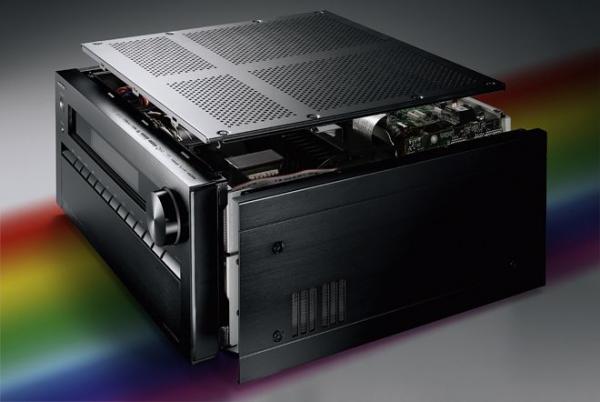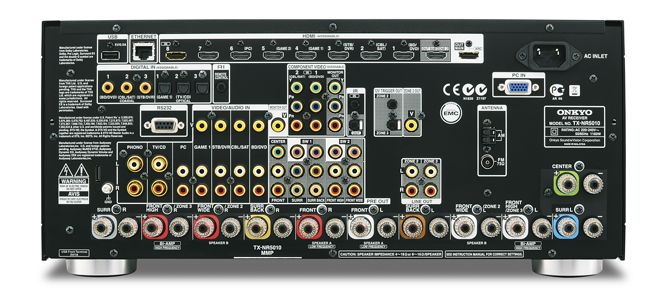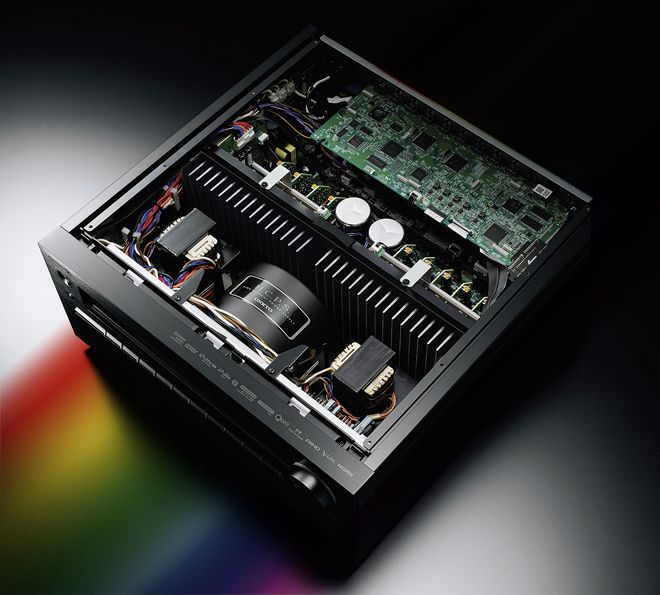Onkyo TX-NR5010 review

Boasting an armoured build that would do Tony Stark proud, Onkyo’s new TX-NR5010 receiver is a mouth-watering proposition - a 25kg home cinema heavyweight boasting state-of-the art audio/visual processing and unbending muscle.
Just unboxing the thing is enough to send adrenalin pumping through the veins. This hardcore hero has nine channels of amplification resident, expandable to 11 if you add a second stereo amp. Yes, I know what you’re going to say - there’s no software to drive such a configuration. That’s where this amp’s variable channel upmixing comes into its own. Not that it makes living with so many speakers any easier, you understand.
Personally, I’ve always relished time spent with Onkyo’s best-of-breed. While the brand’s top-selling mid-rangers traditionally beat out the competition when it comes to bells and whistles, they’re not volume monsters and can sound a little ragged when pushed hard. The models from the brand’s upper echelons are much more likely to stand their ground.
The good news is that they don’t come any feistier than the TX-NR5010. This £3,000 colossus is rated at 9 x 220W into 6 Ohms (160W into 8 Ohms). It can bring the thunder faster than Thor can waggle a hammer.
Admittedly, the TX-NR5010 shares a great deal of functionality with the far more affordable TX-NR818, including networking prowess and HDMI GUI slickness. But it massively ups the quake quotient and channel options. Those with larger rooms and a hankering for holographic sound will find the up-spend easy to justify. If you don’t need quite the same level of muscle, then Onkyo offers a step down rig, the TX-NR3010.
Despite its sophistication, the TX-NR5010 maintains clean family lines. The majority of on-body controls are hidden away behind the fascia flap, beneath which you’ll find easy-access analogue phono, digital audio and HDMI source inputs; the latter is compatible with the Mobile High-Definition Link standard for smartphones, which may prove useful if you have HD content downloaded to your mobile that you want to play out.
Hooking up the beastConnectivity on the TX-NR5010 is extensive. The number of rear-panel HDMI inputs stretches to eight, all of which are 3D compatible. HDMI pass-through is also supported, so you don’t actually need to power up the box just to see what’s on. There are also seven digital audio inputs (four optical and three coaxial), two component inputs, a second USB and a PC VGA input. You even get two independent subwoofer outputs, each able to support two subs (a sure sign of this AVR’s insane bent). It’s worth noting that there are no analogue audio inputs, though. Onkyo in its wisdom has decided to consign them to history; consequently you’ll need to use HDMI for all multichannel sources. At least DSD Direct is provided for Super Audio CD players.
There are two HDMI outputs. In most home theatres these will be assigned to screen and projector. However, here Onkyo also allows one to function as a Zone 2 HDMI output. This significantly simplifies setting up a multiroom HD system, but I can’t help feeling that power users would rather not sacrifice the second local HDMI output just to get that second zone feed. What the TX-NR5010 should really offer is a trio of HDMI outs. Powered audio is available in up to three zones simultaneously.
The Osaka-based brand has made large strides when it comes to app functionality and music streaming. The latest Onkyo Remote 2 app for iOS and Android can stream direct to the TX-NR5010, with format support for Apple Lossless, MP3, WAV and AIFF. Alternatively, the receiver can be used with the brand’s new UBT-1 Bluetooth 3.0 adapter, which utilises the CSR aptX compression reduction codec to give a nice lift to the dynamic range of compressed audio files. The adaptor is a diddy device that plugs into the USB port on the front of the box.
Networking is best achieved via Ethernet, but there’s also an optional UWF-1 wireless LAN adapter available. Home automation options come via RS-232 and a couple of 12V triggers.

The TX-NR5010’s specification is certain to start any home theatre addict drooling. THX Ultra2 Plus certification guarantees that reference level audio can be delivered 3.5m from the screen, and that the receiver is suitable for deployment in rooms measuring up to 85 cubic metres in size. In addition to THX accreditation, there’s onboard ISF (Imaging Science Foundation) video calibration support. Naturally, the unit can deal with all relevant codecs, from familiar DTS-HD Master Audio and Dolby TrueHD soundtracks to height/width variants Audyssey DSX and Dolby Pro-Logic IIz.
While the TX-NR5010 may look initially intimidating when first heaved from its box, a Quick setup routine calmly directs you though installation and configuration. This includes the Audyssey room-correction routine and source components. Setting up proves no more difficult than installing a TV.
Audyssey MultEQ XT32 can be run either in a Quick Start mode, which is optimised for a single seating position, or Full Calibration, which can measure up to eight seating positions. In terms of speaker distance and levels, I found this auto-pilot to be largely on the money, although as a matter of preference I didn’t much care for Mr Audyssey’s chosen crossovers (40Hz on my centre channel? Pah), so some manual tinkering was required.
The AVR also offers the standard Audyssey Dynamic Volume and Dynamic EQ filters, but my advice is to leave both these off.
The supplied remote control (which is standardised across the Onkyo range) is relatively clean and understandable. Similarly, the AVR’s user interface is extremely easy to live with. An HDMI overlay makes for intuitive navigation and menu selection, with funky InstaPrevue picture-in-picture previews appearing on inputs before you select them.
Once you’ve taken the receiver online, there’s a wealth of audio services to feast on: Simfy, Last.FM, Aupeo!, Spotify Premium, Mp3.com and vTuner internet radio. This 'net interface also opens up DLNA and Home Media access; selecting these reveals DLNA devices and Shares, retrospectively, on your network. File support is generally excellent. The AVR happily played MP3, AAC, WAV, FLAC and WMA tracks from my various NAS boxes; from USB it could also handle Ogg Vorbis and Dolby MLP. If there’s album art with your MP3s, it’ll render that too. Somewhere amid all this feature richness there’s also an antiquated FM tuner. While some users may deem steam radio to have some level of source relevance, I haven’t listened to it in years and wager you haven’t either.
Burdened with glorious purposeAs a movie machine, the TX-NR5010 rocks on an Asgardian scale. The 7.1 DTS-HD MA soundtrack of Marvel's Avengers Assemble is not only one of my new favourite reference mixes, it’s also tailor made for the Big Onk. When Loki opens the doors to the Tesseract in reel one, the receiver ripples apocalyptic LFE throughout the room - and there’s audibly power to spare. This is an AVR lesser mortals will actually feel nervous about maxing out. Likewise, when Thor’s sibling starts slamming S.H.I.E.L.D grunts around the front soundstage, you’ll rightly fear for the structural integrity of your walls. As is its want, Onkyo increments the volume numerically; when it reaches 82 you’re at 0dB reference level. I rarely felt safe venturing beyond the low seventies.
The TX-NR5010 may be an unabashed home theatre titan, but it’s not without audiophile sensibilities. Multichannel music has live-venue vitality. Emi Fujita’s Camomile Best Audio SACD (Pony Canyon, Japanese import), listened to in Pure Audio mode DSD Direct, pours forth high and wide. Vocal articulation is heart-achingly precise and there’s an almost three-dimensional resonance to her band. Those that want to bi-wire and bi-amp the front channels can take advantage of a new differential DAC mode and digital crossover processing network.
There are four audio presets available: Movie/TV, Music, Game and THX. While I don’t use THX-certified loudspeakers I retain a soft spot for THX post-processing, and here with its Ultra2 dusting, it’s as cinematic as a red-carpet night out in Leicester square, wedging out slightly toppy dialogue and smoothing sound steerage. Much to my surprise, I also found the THX Music mode extremely agreeable; it adds a lightness of touch certain to combat any high-volume listening fatigue. Alternatively you can just go direct; neat lossless is never less than thrilling.
In engineering terms alone, the TX-NR5010 borders on magnificent. While it looks much like its cheaper stablemates, it’s considerably more robust, employing a rigid chassis with separate anti-resonant aluminium top and side panels designed to reduce vibration; anchored inside is a huge toroidal transformer, supported by two discrete transformers for audio and video processing. Heat management is considerably better than models down the range, with the lid running nicely warm rather than Teppanyaki hot.
Video processing comes via the HQV Vida VHD1900 module and Marvell’s Qdeo silicon, which offers the ability to upscale all outputs to 4K. There is, of course, no practical benefit to this, outside of being able to tick the Quad HD box early. Onboard audio processing is equally state-of-the-art. PLL jitter-cleaning is applied to all audio signals at the digital-to-analogue conversion stage. Beneath the bonnet are 192kHz/32-bit TI Burr-Brown DACs and 32-bit DSP.

The TX-NR5010 is a home cinema helicarrier of a receiver, bristling with futuristic feature refinements. For such an obviously mental piece of kit it’s surprisingly polite to use. But the real joy of ownership comes through an appreciation of the TX-NR5010's audiophile design and the luscious enthusiasm of its multichannel delivery.
Its predecessor, the TX-NR5009, justifiably won HCC's Reference Status accolade. This update is just as deserving - and worth extending your credit line for.
HCC VERDICT
 Onkyo TX-NR5010
Onkyo TX-NR5010
Price: £3,000 Approx
www.onkyo.co.uk
Highs: Unbeatable build quality; effortlessly powerful multichannel performance; excellent user interface
Lows: No integrated AirPlay; third HDMI output required for independent multiroom and system configuration; Audyssey MultEQ XT32 auto EQ still requires some manual intervention
Performance: 5/5
Design: 5/5
Features: 4.5/5
Overall: 5/5
 |
Home Cinema Choice #351 is on sale now, featuring: Samsung S95D flagship OLED TV; Ascendo loudspeakers; Pioneer VSA-LX805 AV receiver; UST projector roundup; 2024’s summer movies; Conan 4K; and more
|






















































